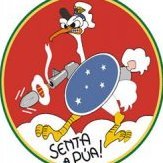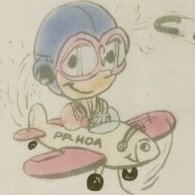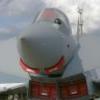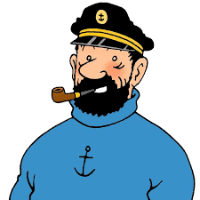-
Posts
52 -
Joined
-
Last visited
Profile Information
-
Gender
Male
-
Location
Earth
Recent Profile Visitors
1,266 profile views
TAG's Achievements

New Member (2/9)
162
Reputation
-
Evening, gents Here's something to stir the pot a little, what if @quangster's kite is actually gloss OD on the overall fuselage (including the fairing gear doors aka clam shell doors) but NG on the lower wings and outer gear doors? That's kind of the vibe I'm getting from this photo, not sure if it's the actual plane in question, but it certainly raises some interesting probabilities, eh? There are most definitely two different colors on this Pony -besides the black and yellow bolt, of course- and interestingly enough, the NG seems to overlap the leading edge and onto the top surface of the wing? Most intriguing!
-
Here you go, Milos: https://www.tapatalk.com/groups/hyperscale/question-on-the-fw-190a8-r11-aircraft-t511604-s10.html
-
There are always pesky exceptions, of course, but I think this period color photo fully corroborates your assessment of the vomit-inducing YZC cockpit in early D's, Darrell. Note that this Jug's two outer .50's are missing on each wing, your guess being as good as mine as to why they were removed. The maintainer's fire extinguisher has "376 F.S." painted on the nozzle and this is clearly Stateside, so probably before the 361st FG was deployed to the 8th AF in November 1943. Let's zoom in! As you can see, this is a D-2-RA (serial number 42-2247) and that cockpit looks nauseatingly yellow to me, at least the hardened steel plate behind the noncom crew chief running up the engine on "his" bird. Of course, one could make the argument that the rest of the cockpit isn't YZC, for example the frame around the armored glass in the windscreen certainly doesn't look yellow, so there's that. But as photos in other threads have shown, those full YZC cockpits were a definite possibility for early D's. In my opinion, there are so many possible variations what with the haphazard nature of wartime manufacturing, I feel it's okay to mix and match interior colors like DDG and IG and YZC because that's how it actually happened on the line in real life, often enough that a mishmash of colors is probably more realistic than a fully uniform cockpit in fact. But again, that's just, like, my opinion, man. Good luck with your build, @Zigomar, looking forward to seeing it come together! Cheers, - Thomaz
-

Looking for USN/USMC camouflage photo’s.
TAG replied to Corsairfoxfouruncle's topic in Aircraft WWII
Hey, all @Corsairfoxfouruncle, that is a modified PBJ from VMB-612, a USMC anti-shipping attack squadron that specialized in night ops. Here's a better version of that single .50 cal in the tail stinger, they got rid of the second fifty to lighten the plane and give them further range (the Pacific is face-meltingly vast) while the rear glazing was removed in an attempt to give the gunner a clearer view, I suppose. The sight atop the Ma Deuce looks to be some variation of the N-8 optical gun sight, but could very well be some other aiming contraption devised specifically for night-fighting. The planes were painted in a very dark blue and, being they were an experimental squadron, 612 actually used rockets instead of bombs to attack Japanese shipping. You can see a few rockets mounted on the port wing in this photo, also note the radome on the starboard wing's leading edge. Some VMB-612 birds had their radars installed in the nose section, giving these PBJ's a very distinct look. Note the cut-down rear glazing on this plane, as well as the single rocket on the starboard wing mount. Here's a link to some of VMB-612's history: https://www.usmilitariaforum.com/forums/index.php?/topic/349685-vmb-612-bombing-squadron-six-hundred-twelve-with-video-link-to-take-a-flight/ Hope that helps, happy new year everyone! - Thomaz- 19 replies
-
- 3
-

-
- USN/USMC WW2
- multi engine aircraft
-
(and 1 more)
Tagged with:
-
Hi @quangster, nice seeing you round these parts! So the answer to your query is NMF, it was all left in bare metal. Note that the flap actuators, the small "arms" that extend and retract the flaps, are in YZC, as is the wheel well. Top side view of the extended flaps, also in NMF. Hit me up if you need more refs, I noticed in another thread that you painted the inside of your cowling in YZC, I hate to be the bearer of bad news but the interior of those should also be in NMF, along with most of the hardware inside the engine section, including the firewall and forward ring frame. J'espère que cela pourra aider! Cheers, - Thomaz
-
Hey, Pat As Tom Probert pointed out, just everything aluminum by default, including wheel wells. The only part of the plane that had any color was the cockpit, which was usually Bronze Green and occasionally Dull Dark Green. Never Interior Green, mind you. Here are a couple of posts where Inch High Guy did a pretty deep dive into B-17 interior colors, including a ton of photos and pages from E&M manuals. I also did a quick scan thru my files and found some tasty refs of Flying Fort interiors. NMF nose in -G models, bombardier/togglier's station. Navigator's station. As noted by Tom, the earlier -F's had soundproofing and insulation in the nose section. The only section of the plane that was fully painted/insulated throughout the B-17's production run was the cockpit. Here's what Bronze Green was supposed to look like. In this period photo, you can see the window frames, seats and center pedestal painted in Bronze Green, while the throttle levers, the armor plating and frames of both seats look to be painted in Interior Green. NMF Radio Room. Up till the -E model and even some very early -F's, this section was also insulated and soundproofed with fabric. Even bulkheads were left in NMF. NMF Waist section looking aft. Note how there are no ammo canisters hanging on the outside of the ball turret, all the ammo was actually contained within the turret itself. Like so: More NMF waist photos. NMF Tail section, in this case the tail gunner survived the direct flak hit and became a POW. Finally, here's a modern photo of an unrestored wheel well, mostly NMF with primered bulkhead and stringers. If you really want a deep dive into the cockpit colors, that is a whole other can of worms. Which, unless you plan on fully exposing the cockpit, is debatable whether it is even worth the effort, seeing as how little can be seen of the interior of a 1/48th scale Fort (not to mention 1/72). I highly recommend checking out Inch High Guy's posts for the full skinny! HTH, - Thomaz
-
Hey, Dave Since you mentioned you plan on building 42-32025 VP-P "Dreambaby" at some point, I figured you might like to have a better version of this very famous original color photo. Here you go, 50 shades of Dark OD 41: And here's a slightly different shot of 42-97503 VP-X "Princess Pat" than the one you posted which shows the severely weathered wing tops to good effect. Note the national insignia on the port wing, obviously a replacement wing section from mid-1943 when they still had the red surrounds on the stars-and-bars (although they kept the newer wingtip, as the Tokyo tank vents can still be seen). Also, in an attempt to avoid the dreaded 'thread drift', that looks a lot like a de-icer boot on the leading edge of PP's port wing, despite them not being present anywhere else on the plane, or on 43-37791 VP-V either, for that matter. Hope that helps, - Thomaz
-
Hey, Stefan The tail wheel "boot" was actually made from sheet metal, not canvas. Apologies for the background glare, had to fiddle with the levels to get the tail wheel details to show up properly on this pic. Factory floor. Here's a relatively modern photo that shows the details of the tail wheel cover more clearly. Hope that helps, - Thomaz
-
Hey there, Stu P-51D-10-NA 44-14450 "Old Crow" most definitely had unshrouded exhaust stacks, here's a higher resolution version of the same photo you posted. Let's zoom in, just to make sure. Nope, no shrouds in sight. Here's another angle, just in case. Note that this plane was delivered in NMF, then painted in green/gray once it was delivered to the 357th FG, then stripped back down to NMF once again, so there are some interesting little details that deviate from your 'normal' NMF P-51D. Like the shape of the antiglare panel, the fact that the port landing gear cover is still painted in gray, that the plane is mostly devoid of stencils. As for other unshrouded Mustangs, they were legion, in all variants and all theaters of war. Pretty easy to find photos all over the internet and any number of reference materials, just gotta do a little digging, is all. Hope that helps, have fun with your build. - Thomaz
-
Most excellent, chapeau DT! @Tbolt
-
For anyone who wants more info and some amazing period photos of the 57th Fighter Group, here's a link to their site: http://57thfightergroup.org/pictures.html If you browse thru the many thousands of photos, you'll find several examples of early D's without the curved lower cowl flaps like this one: But I guess you've decided to go with a different scheme so it's a moot point, Little Chief has plenty of photos (including several in period color) floating around the internet so you'll have plenty of refs to choose from. Have fun with it, looking forward to the build. - Thomaz
-
All Jugs up to P-47C's had the early cowl flap configuration, with a smaller number of flaps that ended on the airplane's centerline. Starting with the D-1, additional cowl flaps became production standard, and even some older Jugs were retrofitted with the new config. Initially there was only one extra flap on each side which were rectangular and had the same width as the other flaps. By the D-5, a second flap was added on each side and by the D-15 their shapes had been changed to a more streamlined design. So basically, unless you're doing an early D you are good to go with the kit's cowl flap configuration. But if you want one from the early days of the European campaign, you'll need to modify the cowl flaps. Hope that helps, drawings courtesy of the Squadron/Signal Aircraft in Action book on the Thunderbolt, a wonderful and highly recommended reference. Cheers, - Thomaz
-
Hey @BikingLampy Just to corroborate what @Tbolt already proved in spades with his excellent post, Jugs were always left in natural metal finish. That finish might have gotten pretty beat up in combat operations but these birds were never painted silver. Re: the darker areas that Tbolt referred to, they are darker because they are actually made of steel, this is because those panels surround the turbo-supercharger ducts and exhausts which get way too hot for aluminum to handle. Here's a photo of Dottie Mae, arguably the most faithful reproduction of an operational WW2 P-47 around today, you can clearly see the darker steel areas in question. Note the aluminum belly panel at the very bottom, also the inner landing gear doors (the ones not attached to the strut) seem darker but that is just because they are stained from exhaust gases as the waste gates sit directly ahead of them when the landing gear is deployed and the door is down. Those doors are made from aluminum like the rest of the airframe, not steel, but it would be a good idea to weather them a bit as it is a characteristic of this airplane, as you can see. In this case a modern photo is actually better to discern those kinds of details. Hope that helps! And just for fun, here's a big ol' photo dump of shiny Jugs that shows their NMF to good effect. I could keep posting more photos, but you get the idea. Good luck with your build! Cheers, - Thomaz
-
TAG started following ANA paint matches database
-
Hey, Fritz Here's the original T.O. for GSB schemes, it doesn't specify ANA 607 for the anti-glare panel, just "non-specular sea-blue" as you can see below. Pretty sure you could get away with just spraying a flat coat on the anti-glare and be done with it. Hope that helps! - Thomaz







